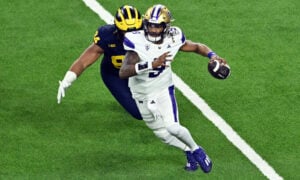New-Age Linebackers
Once upon a time, NFL offenses loved the run game, linebackers were run-tackling machines, and life was good. Nowadays, things are a bit more… fuzzy. Offenses are just as likely to call a swing pass as they are a run up the middle on third-and-two. Because of that, the linebacker position has begun to evolve to match it.
Gone are the days of Levon Kirkland and Jeremiah Trotter, big bodies that you plugged in the middle of your defense who clanged and banged with the running backs coming through the hole. Today’s linebackers will still ring your runner’s bell, but now they’ll also run with your tight end up the seam as well.
Back in the 1990s, Jimmy Johnson and the Dallas Cowboys began to move to a smaller defense. Johnson wanted his fastest defensive players on the field, mostly in the hopes of generating turnovers. For the most part, it was effective (see: Super Bowl titles), but on occasion, they would run into a monster offensive line that simply would be too large to move. Of course, that was back when teams were willing to pound it up the middle.
Today, speed is the trait that is treasured. If a linebacker can’t chase from sideline to sideline, he’s not seeing the field. It’s a big bonus if he can hang in man coverage over the middle too.
“But Doug, you’ve preached for years to find the kinds of players you now say are going the way of the dodo.”
Yes, I have. While I’m a stubborn person, I’m not closed-minded. I used to draft running backs in the first round of startups, then I met Ryan McDowell. There was a time where JJ Watt was supposed to be the first pick of any IDP startup. Dynasty is all about adapting before the tsunami hits, not after.
It was actually ESPN NFL Draft analyst Mel Kiper Jr. during this draft season who first broached the concept. He noted that both Devin Bush and Devin White were now the templates for an NFL linebacker. Both checked in around 6 feet and 240 pounds. Both ran a 4.40-second 40-yard dash. Players of their size and skill set used to label undersized. Not anymore.
I’m not the only one who has explored this subject. DLF’s own champion of charts, Tom Kislingbury, posted this graphic on Twitter earlier in May.

Now, I’m not the statistician that Tom is, but he’s laid this out really well. If you are looking for IDP points, you want players who play in the passing game. That means you are now looking for what was once referred to as coverage linebackers.
But it’s not just the players that have changed. The defenses themselves have moved with the times as well. If you’ve played IDP for more than 15 minutes, you’ll be familiar with the fact that teams spend more time in nickel or dime than they do in “base.” NFL defensive coordinators are playing matchups more than they ever have before. Mostly that means rolling with two linebackers and bringing in an extra safety or corner to help with the extra passing attempts offenses are so in love with.
Evaluation
If the NFL is changing its game, that means that you need to change the way you watch it. More specifically, if you are someone who does your own research, you’ll need to rethink how you evaluate what you’re seeing. How is the linebacker’s lateral quickness? Can he flip his hips and run? Is he asked to cover both running backs and tight ends? Does his team play more man or zone?
Sound familiar? Yeah, those are very similar to the traits you look for in a box safety. Just like we spend our Twitter characters nowadays arguing if a player is an end or linebacker, soon we get to bicker over whether he’s a linebacker or safety (Fun!). But seriously, the line between safety and linebacker is quickly blurring. Linebackers are becoming smaller, thicker, and faster.
One thing that hasn’t changed in your evaluation is that your focus still needs to be between the numbers when watching. It’s just now you’ll need to weigh the passing down heavier than you have in the past.
Many draftniks have been proposing for past several years that the three-cone is actually the most predictive drill at the NFL Scouting Combine. That’s never truer than with today’s NFL linebacker. Both Bush and White were in the top 10 in three-cone score at the 2018 combine.
So what’s all that mean for me and my IDP league?
Not surprisingly, as the NFL changes, so will your league. While your league-mates are still stuck in the old way of thinking, you can take advantage of the new paradigm. Draft capital means players like White and Bush will still be some of the first linebackers off the board in your draft. However, finding those who fit the new size and athletic profile and plucking them in the later rounds will be how you’ll win.
Case in point: Ben Burr-Kirven in Seattle. He had the best three-cone score at the combine. Yes, he was drafted in the fifth round, but he’s comparable in size to White and Bush and ran a 4.56-second 40-yard dash. He is definitely someone you could pluck in the late rounds and find yourself sitting on an IDP steal.
- Sunday Six Pack: Week Four - September 29, 2019
- College IDPs to Watch This Season - August 1, 2019
- New-Age Linebackers - June 14, 2019

































































